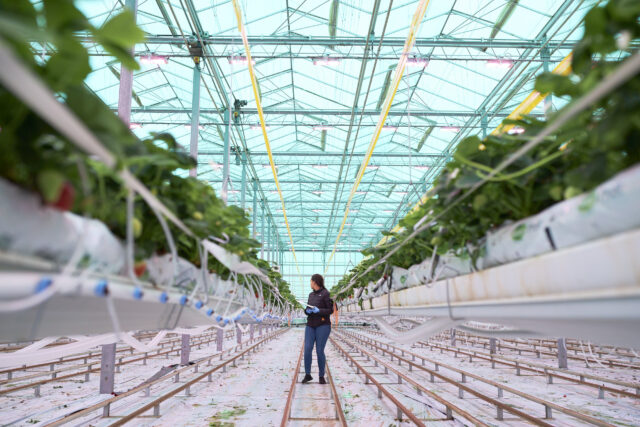By Keith Bradley, vice president of information technology and security at Nature Fresh Farms Sales Inc.
Meeting the unrelenting consumer demand for fresh produce requires more than just the trifecta of sunlight, water and fertilizer. A new paradigm for automation in farming is emerging that requires meticulous orchestration of every facet of cultivation, from ambient temperature control to pest mitigation. This surge in precision agriculture is powered by data-driven methodologies that enable growers to optimize yields in greenhouses laden with an array of fruits and vegetables.
One of the leading innovators using advanced farming techniques is my company, Nature Fresh Farms, headquartered in Leamington, Ontario. We now have about 250 acres across Canada, and the United States, growing produce, such as tomatoes, peppers, cucumbers, and strawberries. As the vice president of information technology at Nature Fresh Farms, I have helped to deploy scalable technology solutions that enable us to maximize output, with yields as much as 10 times greater than conventional farms.
Growing with innovation

Underpinning our success at Nature Fresh Farms is a history of innovation. Since Peter Quiring launched the company in 1999, data-driven automation has been essential for tasks such as regulating greenhouse conditions and monitoring the health of plants.
Our results underscore the value of using technology for every facet of our operations. Quality is the coveted end to our technological means. Regardless of what industry you are in, your roadmap to innovation should be guided by meticulous data analysis.
We’ve learned, for example, to use artificial intelligence (AI) to produce powerful insights from data, whether it’s analyzing video footage of plant lifecycles, optimizing robotic pickers, or comparing the yields from different varietals. For instance, understanding the best temperature for extending the shelf life of a pepper requires the ability to track and monitor copious amounts of data. This orchestration also extends to yield management, with AI processing support guiding the deployment of beneficial insects to annihilate pest incursions and automatically controlling water cycles.
Data management is mission-critical when it comes to harvesting insights that will foster innovation. Our Extract, Transform & Load (ETL) metrics have evolved dramatically thanks to sophisticated machine learning algorithms and on-premises data storage. In particular, our ETL compute time has been reduced from hours to minutes. Access to real-time data enables us to iterate and test any variable with instant results.
Automation plays an important role in helping us implement sustainable growing strategies. – Keith Bradley, vp of information technology and security, Nature Fresh Farms
Relying on data-driven infrastructure

We store and manage a massive amount of data, ranging from images of plants to constantly changing environmental variables. All of our unstructured data is stored on-premise in S3 buckets. The key is to have on-demand access to data and analytics in real-time—without the latency caused by sending it from the edge to the core or the cloud for processing. Our on-premise cloud configuration enables us to process large data flows at the edge from sources such as sensors, cameras and machine learning algorithms.
Nature Fresh Farms has been developing a truly autonomous greenhouse operation for more than a decade. Moving data from the edge to the core requires a high-performance storage infrastructure. We use a flexible and scalable NAS solution that supports massive workloads and enables the use of AI for real-time processing and decision-making.
The amount of data we process is staggering. For example, we collect and store an average of 11.3MB per plant per month for 2 million plants. That’s 22 terabytes of just plant data storage. In addition to that, we generate transactional data for everything from climate control readings to video files.
We depend on a centralized file storage infrastructure capable of working in a multi-cloud network. On-premise data management gives us up-to-the-minute reports that help us monitor and manage costs related to every facet of our operations.
We’re also using technology to facilitate a “work-from-anywhere” IT environment. Implementing this type of integration benefits our team by giving us the ability to manage multiple endpoints and container security capabilities from one console. We’ve learned that centralization can simplify our security stack and provide strong protection against security threats. By reducing complexity at the edge, we can better protect our data while having access to the insights needed to generate more value for the business.
Automation also plays an important role in helping us implement sustainable growing strategies. Our growing practices include a closed-loop water system for conserving water, and we heat our greenhouses using biomass boilers.
Partnering with the right solutions providers

Innovation requires more than just a good idea and a quality product. You need well-trained people in-house and the right partners to build a successful company. Today, whether we need a data center solution or a switch, we know we can rely on both our internal network and the expertise of Dell Technologies to keep our greenhouses running at full speed.
As we explore even more automation, such as robotic crop monitoring and automated harvesting, it’s essential we implement the right AI and computing solutions to meet our needs. For other IT decision-makers, regardless of your industry sector, it’s important to understand that automation invariably comes with a learning curve. There is no “one-size-fits-all” solution. You need to partner with companies that provide flexible and scalable technology that can be customized for your specific use cases.
If you’re thinking big, you better be thinking about big data, too. The Innovation Index survey of IT decision-makers found that 57% believe their technology is not cutting-edge. Reducing complexity, avoiding data silos, and modernizing your tech stack are essential for maintaining a competitive edge.
Moreover, as we’ve discovered, using an on-premise cloud infrastructure provides a powerful way to turn data into decisions that drive innovation.
In a marketplace that requires constant innovation, symbiosis is our guiding light. At Nature Fresh Farms, we have cultivated a profound understanding of how flexible, scalable solutions can help grow both plants and profits.
Innovators We Love is a recurring series on Dell Perspectives that highlights bold leadership in innovation. For more information, check out the Dell Innovation Index on how to cultivate innovation resilience in turbulent times. To read more stories about innovation, be sure to visit our Leadership and Innovation page.
Lead photo courtesy of iStock

